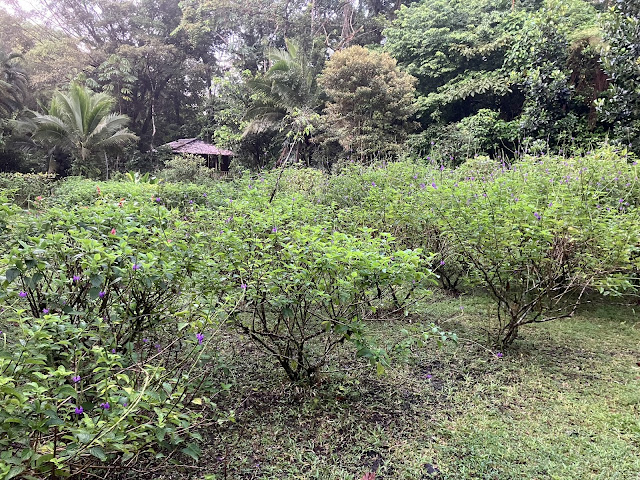With its rich burgundy plumage topped by a shocking white crown, the Snowcap male is one of the most instantly recognisable hummingbirds of the Neotropics. So recognisable, in fact, that our guide Pat O'Donnell's description of himself when we first met at San Jose airport was: "look for the guy with the Snowcap t-shirt". We found him with no difficulty.
Even within such a showy family as the hummingbirds, the Snowcap Microchera albocoronata stands out. No other hummer has the combination of a white cap and a body colour that varies from gold to bronze to burgundy to something best described as "beetroot" depending on how the light is shining on it. This is all down to the iridescent plumage of course, which itself is a function of the shape and position of pigment cells within the detailed stucture of the feathers.
The result is - literally - breathtaking, producing in my case an involuntary gasp of excitement. We were returning from a morning's walk along the trails at Pocosol Biological Station, which had produced such delights as a Checker-throated Antwren and a close view of a Bicolored Antbird, and had just passed the accommodation building when Pat gestured urgently towards a small line of Porterweed bushes. There on the top, positively glistening in the morning sunshine, was my first Snowcap. And it was just as well that the bird is so easy to identify. Within a couple of seconds it had gone, chased away by the jealous and attentive Rufous-tailed Hummingbird that had laid claim to this precious source of nectar. Rufous-tailed hummers are bullies!
Unfortunately, the sighting had been so brief that my birding companion Richard missed it. To make matters worse, the Snowcap failed to reappear despite much searching. As all birders will know, it is intensely frustrating when you have failed to spot a bird that the others have seen, and when that bird is as sensational as a Snowcap it can all get a bit awkward. Despite putting a brave face on it, Richard was clearly put out. And while I could be excused a bit of smugness about being in the right place at the right time to "tick" the bird, what I really wanted was a more leisurely encounter, and, ideally, the opportunity to take a few photographs. But Pat decided to rise to the challenge. Finding another Snowcap became a top priority.
The Snowcap is a hummingbird of the Caribbean slopes, ranging from Honduras in the north to Panama in the south. Like many Costa Rican species it is fussy about altitude. At around 720 metres above sea level, Pocosol is near the upper limit of its range, while it is rarely located below 300 metres, although this may be because so much of Costa Rica's lowland rainforest has been destroyed. Fortunately Pat has
literally written the book about where to watch birds in Costa Rica (link here), plus a useful blog about Costa Rica's best Snowcap-finding locations, so there could be few better people to steer us towards another one.
We succeeded a couple of days later at Centro Manu, a small family reserve lower down the Caribbean slope near Guapiles. It didn't look hopeful at first: we arrived in a torrential downpour and had to take shelter in reception building.
 |
| A wet afternoon at Centro Manu reserve |
When the rain eased off, we decided to explore the reserve's small network of trails. These were very wet indeed - wellies were essential - and the forest was quiet. It seemed as if the arrival of rain in the later afternoon had prompted the local birdlife to simply shut up shop early for the night. All quite dispiriting. But on returning to reception, Pat was not so easily discouraged. "We'll just try the hummingbird garden while there's still light," he announced. The rain was still lightly spotting as we headed down the track, with - it must be said - low expectations.
 |
| Centro Manu - the hummingbird garden |
The hummingbird garden (above) turned out to be a forest clearing containing a variety of small flowering shrubs. There didn't seem to be much activity, but we stationed ourselves at a suitable vantage-point and waited. And a hummingbird duly arrived, albeit a Rufous-tailed hummer which began to patrol the bushes in a typically defensive manner. This didn't bode well.
%2015.10.24.JPG) |
| Rufous-tailed Hummingbird (from Pocosol) - a bit of a bully! |
A couple of Montezuma's Oropendolas flapped overhead, and a Blue-chested Hummingbird made a brief appearance high in a nearby tree. This was good, but still not what we were really after.
And then, as in all of the best stories, we hit success. Weirdly, two male Snowcaps arrived almost simultaneously. One popped up high in the tree where we'd seen the Blue-chested; I called out "Snowcap!", while Richard shouted out the same thing. I assumed at first that we were both looking at the same bird, but then discovered that he had spotted one down on the Porterweed bushes. This second bird then perched obligingly on a bush at the opposite side of the clearing, and I was able to advance some distance towards it brandishing my Canon, which I'd put on a suitably high ISO setting. I didn't want to disturb the bird by getting too close, but even from where I was standing, its colours seemed to light up the gloomy evening.
Fittingly, it was the final bird of the day. We drove away from Centro Manu into the gathering darkness and made our way back to our base for the night at La Quinta de Sarapiqui. It was our last full day on Costa Rica's Caribbean slope, but further adventures awaited over the mountains on the Pacific coast.
And it is there that we shall meet my final choice for the Top Ten Birds of Costa Rica.

%2018.10.24.JPG)

No comments:
Post a Comment